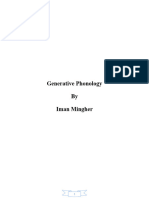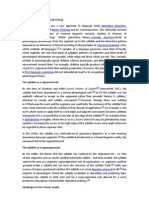Naturalness Versus Markedness
Naturalness Versus Markedness
Uploaded by
Ahmed S. MubarakCopyright:
Available Formats
Naturalness Versus Markedness
Naturalness Versus Markedness
Uploaded by
Ahmed S. MubarakCopyright
Available Formats
Share this document
Did you find this document useful?
Is this content inappropriate?
Copyright:
Available Formats
Naturalness Versus Markedness
Naturalness Versus Markedness
Uploaded by
Ahmed S. MubarakCopyright:
Available Formats
Naturalness versus Markedness Naturalness - denotes (1) ease of production, and (2) frequency of sounds in languages Markedness - opposite
te of naturalness, sounds are more difficult, less frequently occurring Related to development, natural sounds are acquired earlier by children and marked sounds tend to be acquired later Sound cognates are typically described as marked versus unmarked
Markedness Principles Voiceless obstruents are more natural than voiced obstruents Obstruents are more natural than sonorants Stops are more natural than fricatives Fricatives are more natural than affricates Low front vowels are the most natural vowels Close-tense vowels are more natural than open-lax vowels Anterior consonants are more natural than nonanterior consonants
Markedness and Implied Universals Fricatives imply stops Voiced stops imply voiceless stops Thus, whenever a more marked aspect is seen in the language, the unmarked cognate is assumed This idea has also been applied to childrens phonological systems
Natural Phonology Proposed by Stampe to describe phonological development Natural phonology hypothesizes that patterns of speech are governed by an innate, universal set of phonological processes Phonological Process - a pattern of substitution that applies to a class of sounds which are difficult for an individual All children use the phonological processes as they learn the phonological rules of their language and as their motor system develops Development and Natural Phonology Childs innate phonology is continuously revised toward the adult system, passive process 3 mechanisms: (1) limitation - differences in childs system compared to adult system become limited to specific sounds or sequences (2) ordering - substitutions that appear random or unordered become ordered (3) suppression - elimination of childs phonological processes to fit adult language Phonological Processes Disordered child is not progressing with suppression of processes as expected Phonological processes are useful clinically used to describe the patterns of errors do not need to agree with the original idea that phonological processes explain acquisition and disorder Natural Processes - phonological processes that occur crosslinguistically
Natural Processes Assimilatory processes Described in BBF as similar to co-articulation processes Nonassimilatory processes Omission and substitution processes Epenthesis insertion of a sound, usually in a cluster (e.g., blue is /blu/) Metathesis reversal of sounds (e.g., ask is /Qks/)
Linear versus Nonlinear Phonologies emphasis on serial sequence of segments segments = bundles of features all sound segments have equal value phonological rules apply only at the level of the segment and distinctive features propose a tiered or hierarchical arrangement segments = distinctive features that are ordered some features dominate other features phonological rules are affected by the sentence, word, stress, syllable, segment, and features
Nonlinear Phonologies Autosegmental Phonology a feature can operate independently, although within the hierarchical structure Metrical Phonology specifically deals with the dimension of stress Feature Geometry focused on the ordering of features, explain spreading and deletion processes
You might also like
- The Drama of Speech Acts: Shakespeare's Lancastrian TetralogyFrom EverandThe Drama of Speech Acts: Shakespeare's Lancastrian TetralogyNo ratings yet
- Test7 ResultsDocument3 pagesTest7 ResultsWahidatul HusnaNo ratings yet
- Study Guide PDFDocument4 pagesStudy Guide PDFRobert Icalla BumacasNo ratings yet
- Lecture One: Introduction To The Course of SemanticsDocument14 pagesLecture One: Introduction To The Course of SemanticsJana WaelNo ratings yet
- Engendering InterpretationDocument22 pagesEngendering InterpretationAhmed S. MubarakNo ratings yet
- 6-Naturalness and StrengthDocument9 pages6-Naturalness and StrengthMeray HaddadNo ratings yet
- Phonetic and PhonologyDocument57 pagesPhonetic and PhonologyjimmyNo ratings yet
- The Notion of CorrectnessDocument23 pagesThe Notion of CorrectnessAtiqah Hamid80% (5)
- First Language AcquisitionDocument21 pagesFirst Language AcquisitionKeith Wheeler100% (1)
- Kisii UniversityDocument5 pagesKisii UniversityRobert LangatNo ratings yet
- Words, Sentence and Dictionaries. MorphologyDocument5 pagesWords, Sentence and Dictionaries. MorphologyNur Al-AsimaNo ratings yet
- Lecture 8 Deixis Discourse Analysis Lecture NotesDocument3 pagesLecture 8 Deixis Discourse Analysis Lecture NotesMihaela Codrina AntonNo ratings yet
- Generative PhonologyDocument20 pagesGenerative PhonologyAhmed MubarakNo ratings yet
- Variation & Language VLCDocument18 pagesVariation & Language VLCAmirAli MojtahedNo ratings yet
- Grammar and Syntax (Notes) - 1Document22 pagesGrammar and Syntax (Notes) - 1Saeed Ahmed Chachar100% (1)
- Linguistics, Penguin: Module 2 Unit 2 Error Analysis 1Document7 pagesLinguistics, Penguin: Module 2 Unit 2 Error Analysis 1Dedeh KurniasihNo ratings yet
- A Brief Study On Syllable DivisionDocument5 pagesA Brief Study On Syllable Divisionisraramone0% (1)
- UPP - 2 - Practice Exercises (Phonological Variation and Underlying Representations)Document3 pagesUPP - 2 - Practice Exercises (Phonological Variation and Underlying Representations)essaywritingNo ratings yet
- SemanticsDocument38 pagesSemanticstantipbicNo ratings yet
- TheoryDocument5 pagesTheoryMohammad Jahidul IslamNo ratings yet
- Chapter 11 - Yes-No Questions - The Grammar Book - Form, Meaning, and Use For English Language TeachersDocument22 pagesChapter 11 - Yes-No Questions - The Grammar Book - Form, Meaning, and Use For English Language TeachersHồ Quang TrungNo ratings yet
- Generative Phonology: Presented By: IRMA MAMING (2020203879102001) FADHILAH SANTRI (2020203879102002)Document9 pagesGenerative Phonology: Presented By: IRMA MAMING (2020203879102001) FADHILAH SANTRI (2020203879102002)fadhilah santriNo ratings yet
- Overview of English Linguistics CompilationDocument10 pagesOverview of English Linguistics CompilationIta Moralia RaharjoNo ratings yet
- Parker - Handouts Intro Phonology PDFDocument210 pagesParker - Handouts Intro Phonology PDFRyan Jefrey GallanoNo ratings yet
- Morphology PresentationDocument11 pagesMorphology PresentationMajda NizamicNo ratings yet
- Dissimilation: A. DefinitionDocument2 pagesDissimilation: A. DefinitionayualitanthariNo ratings yet
- Psycholinguistics CompleteDocument30 pagesPsycholinguistics CompleteSiti QomariahNo ratings yet
- Lexico GrammarDocument4 pagesLexico GrammarELSANo ratings yet
- 2-Is Linguistics A ScienceDocument14 pages2-Is Linguistics A Sciencealex darudeNo ratings yet
- Module Applied LinguisitcsDocument93 pagesModule Applied LinguisitcsJohn WilkinsNo ratings yet
- Universitas Sumatera UtaraDocument13 pagesUniversitas Sumatera Utarahety hidayahNo ratings yet
- Aen 300Document49 pagesAen 300BrianNo ratings yet
- Cognitive Linguistic Vs Autonomous OneDocument6 pagesCognitive Linguistic Vs Autonomous OneLamiiaa Lagriba LagribaNo ratings yet
- Hehe Language: GrammarDocument2 pagesHehe Language: GrammarAhmad EgiNo ratings yet
- Language & Linguistics - Professional Communication Questions & Answers - SanfoundryDocument11 pagesLanguage & Linguistics - Professional Communication Questions & Answers - SanfoundrySTANLEY RAYENNo ratings yet
- Sound Assimilation in English and Arabic A Contrastive Study PDFDocument12 pagesSound Assimilation in English and Arabic A Contrastive Study PDFTaha TmaNo ratings yet
- SonorityDocument13 pagesSonorityDewi SafiraNo ratings yet
- Yule Chapter 20 NotesDocument4 pagesYule Chapter 20 Notestsm hashinshinNo ratings yet
- Phonetics (First Year English) Guerfi HindDocument28 pagesPhonetics (First Year English) Guerfi HindAlla L'GameurNo ratings yet
- Language Variation 1223893463303688 9Document28 pagesLanguage Variation 1223893463303688 9Stella Ramirez-brownNo ratings yet
- Analysis of ConversationDocument3 pagesAnalysis of ConversationRiska NurhayatiNo ratings yet
- Phonetics and Phonology Are The Two Fields Dedicated To The Study of Human Speech Sounds and Sound StructuresDocument11 pagesPhonetics and Phonology Are The Two Fields Dedicated To The Study of Human Speech Sounds and Sound StructuresKisan SinghNo ratings yet
- Chapter 15 Gestures and Sign Languages: The Study of Language, 5 Edition George YuleDocument8 pagesChapter 15 Gestures and Sign Languages: The Study of Language, 5 Edition George Yulesovanrat KhievNo ratings yet
- Linguistics NotesDocument85 pagesLinguistics NotesArfeen AleeNo ratings yet
- An Introduction To Applied LinguisticsDocument30 pagesAn Introduction To Applied Linguisticspriya avaisNo ratings yet
- What Is Language AcquisitionDocument7 pagesWhat Is Language AcquisitionMuhammad AbidNo ratings yet
- Language & Linguistic, Phonetics & Phonology ReviewDocument32 pagesLanguage & Linguistic, Phonetics & Phonology ReviewMary Quincy MarilaoNo ratings yet
- دكتور هاشم 1Document6 pagesدكتور هاشم 1anmar ahmed0% (1)
- Schools of LinguisticsDocument3 pagesSchools of LinguisticsJake WyattNo ratings yet
- لغويات مقارنة 1703Document276 pagesلغويات مقارنة 1703hazemNo ratings yet
- Unit 5 - Phonology-Some Basic ConceptsDocument12 pagesUnit 5 - Phonology-Some Basic ConceptsNguyễn Hữu NguyênNo ratings yet
- Chapter 1Document4 pagesChapter 1Nikoleta RudnikNo ratings yet
- Stylistics - Lesson 1 PDFDocument13 pagesStylistics - Lesson 1 PDFCherry Mae J. GapatanNo ratings yet
- Feature HierarchyDocument8 pagesFeature HierarchyPaul Chinaza DeborahNo ratings yet
- PhoneticsDocument3 pagesPhoneticsعبد الرحيم فاطميNo ratings yet
- Morphological Structure of A Word. Word-Formation in Modern English 1. Give The Definition of The MorphemeDocument22 pagesMorphological Structure of A Word. Word-Formation in Modern English 1. Give The Definition of The MorphemeIvan BodnariukNo ratings yet
- Group 8 Stress in Simple WordsDocument11 pagesGroup 8 Stress in Simple WordsCông NguyênNo ratings yet
- Differences Between Oral and Written DiscourseDocument44 pagesDifferences Between Oral and Written DiscourseMj ManuelNo ratings yet
- Morphophonemics of EnglishDocument9 pagesMorphophonemics of EnglishLamnguyentai100% (2)
- Multilingual Speech CommunitiesDocument9 pagesMultilingual Speech CommunitiesAris PetNo ratings yet
- 541 TheoriesDocument11 pages541 TheoriesIman AlshemmeryNo ratings yet
- Free and Bound MorphemesDocument2 pagesFree and Bound MorphemesAhmed S. MubarakNo ratings yet
- Sociolinguistic VariablesDocument3 pagesSociolinguistic VariablesAhmed S. Mubarak100% (1)
- Negated Antonyms and Approximative Number Words: Two Applications of Bidirectional Optimality TheoryDocument31 pagesNegated Antonyms and Approximative Number Words: Two Applications of Bidirectional Optimality TheoryAhmed S. MubarakNo ratings yet
- Derivational and Inflectional MorphemesDocument3 pagesDerivational and Inflectional MorphemesAhmed S. MubarakNo ratings yet
- Journal of Humanistic and Social StudiesDocument166 pagesJournal of Humanistic and Social StudiesAhmed S. MubarakNo ratings yet
- Group BDocument6 pagesGroup BAhmed S. MubarakNo ratings yet
- The Syllable in Generative PhonologyDocument4 pagesThe Syllable in Generative PhonologyAhmed S. MubarakNo ratings yet
- How The Brain Organizes LanguageDocument2 pagesHow The Brain Organizes LanguageKhawla AdnanNo ratings yet
- A Probabilistic Analysis of English BinomialsDocument47 pagesA Probabilistic Analysis of English BinomialsAhmed S. MubarakNo ratings yet
- The Importance of Teaching Culture in EFL ClassroomsDocument7 pagesThe Importance of Teaching Culture in EFL ClassroomsAhmed S. MubarakNo ratings yet
- Theories of IronyDocument3 pagesTheories of IronyAhmed S. MubarakNo ratings yet
- Irony in The Semantics-Pragmatics InterfaceDocument13 pagesIrony in The Semantics-Pragmatics InterfaceAhmed S. MubarakNo ratings yet








































































